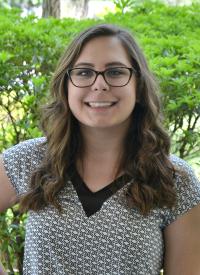You are here
Dahlia Baker
Coe College
NASA Goddard Space Center Intern

NASA Goddard Space Flight Center
Position details
Cosmic Microwave Background Polarimetry
Recent cosmological results have indicated that the universe may have undergone a period of rapid accelerated expansion within its first fraction of a second. This expansion, known as cosmic inflation, would have produced primordial gravitational waves that imprint a faint telltale polarized signature on the relic cosmic microwave background radiation. NASA Goddard is currently developing technology for two pathfinder experiments to measure the polarization of the cosmic microwave background to search for evidence of cosmic inflation in the early universe. The enabling technologies currently under development include highly sensitive cryogenic detectors and quasioptical polarization modulators.
Dahlia is working with the team to further the detector and modulator development. She is testing existing devices, analyzing test data, and designing laboratory test structures.
Final presentation
![]() Absorber Coatings for Mid-Infrared Astrophysics
Absorber Coatings for Mid-Infrared Astrophysics
Control over optical response is an important aspect of instrument design for astrophysical imaging. Here we consider a mid-infrared absorber coating proposed for use on HIRMES (High Resolution Mid-Infrared Spectrometer), a cryogenic spectrometer which will fly on the SOFIA (Stratospheric Observatory for Infrared Astronomy) aircraft. The aim of this effort is to develop an absorptive coating for the 20-200 microns spectral range based on a graphene loaded epoxy binder (Epotek 377H) and glass microsphere scatters (3M K1). The coatings electromagnetic response was modeled using a Matlab script and the glass microspheres were characterized by the measured size distribution, the dielectric constant, and the filling fraction. Images of the microspheres taken by a microscope were used to determine the size distribution with an ImageJ particle analysis program. Representative test samples for optical evaluation were fabricated for characterization via infrared Fourier transform spectroscopy. The optical tests will determine the material’s absorptance and reflectance. These test results will be compared to the modeled response.
I'm a physics and mathematics major at Coe College in Cedar Rapids, Iowa. For the past two years, I've studied the transport mechanisms of the transmembrane protein HpUreI using molecular dynamics simulations and computational methods. I love physics and I'm very motivated to begin studying in a new area. My main interest in physics is astronomy and astrophysics, and I hope to gain a much better understanding of these fields after a summer at NASA. I am fascinated by the unknown reaches of the universe and I want to aid in discovering what all is out there past our own world. After I receive my bachelor's degree, I aim to pursue a doctorate in astrophysics and someday be a research scientist that helps humankind stretch our realm of knowledge.
I'm originally from Boerne, Texas. In my free time, I enjoy hiking, camping, reading, and playing trombone with a jazz band. I am also a member of the Alpha Omicron Pi fraternity where I serve as the Chapter Treasurer, and I am an active member of my college's physics club, serving on the executive board as Event Coordinator. I love adventure and I cannot wait to spend my summer in Washington, D.C. I'm excited to do research in a field I love and to take advantage of all of the opportunities that SPS has made possible.

